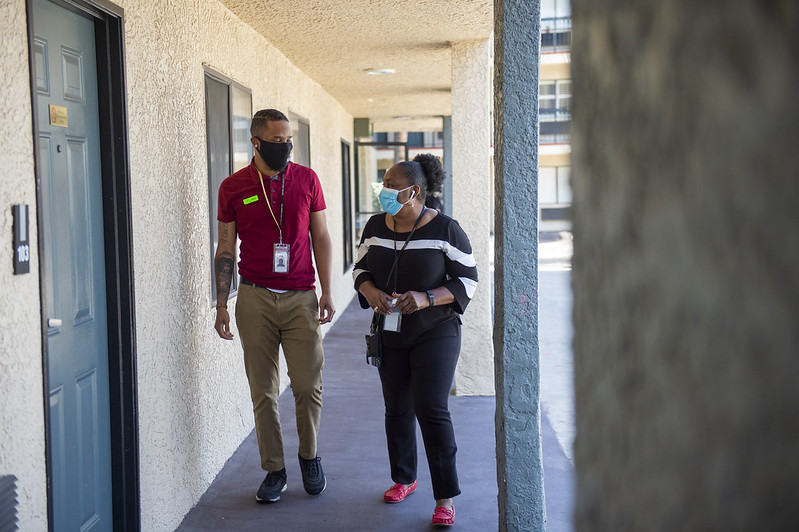As California’s homelessness crisis has continued to grow, so has the range and scale of efforts to address it. To understand these efforts in greater depth and inform their ongoing implementation, the Terner Center, Abt Associates, and UCSF’s Benioff Homelessness and Housing Initiative (BHHI) collaborated on a research project focused on homelessness in California, which will result in a series of briefs and reports over the coming months.
Our findings come from hundreds of interviews with people with lived experience of homelessness, local government administrators and staff, nonprofit service providers, and other stakeholders from local homelessness and housing organizations throughout California. Read more about the study’s qualitative methods here. We also analyzed quantitative data from local homelessness service, shelter, and housing programs.
The first report in the series, Five Recent Trends in Homelessness in California, describes the number and characteristics of people experiencing homelessness in California and documents trends in the available shelter and housing across the state. The patterns presented in the brief underscore the need for sustained resources to address homelessness, ensure equitable service provision, and expand the production of affordable housing. Read the full report here.
The Statewide Homelessness Assessment
The California Interagency Council on Homelessness (Cal ICH) submitted a report to the state legislature, Statewide Homelessness Assessment, in February 2023 that assessed state-directed funding to address homelessness over the course of three fiscal years (2018–2021). Produced in collaboration with the Terner Center, Abt Associates, and BHHI, the report presents quantitative findings on: the sources and intended uses of $9.6 billion in state-directed funding designed to address homelessness and the types of interventions supported with that funding. The report also analyzes the characteristics and outcomes of the approximately 570,000 unique people served by local homelessness service, shelter, and housing programs, including an estimated 273,000 people served by programs supported at least in part by state funding.
The report is the first in-depth analysis of Cal ICH’s Homeless Data Integration System (HDIS), a powerful tool for understanding the reach and effectiveness of homelessness programs statewide.

Distinct Populations Served by California’s Homelessness Programs
Many homelessness programs target specific populations, reflecting their unique circumstances and needs. Leveraging the unique strength of HDIS data, a statewide aggregation of data collected by local homelessness service, shelter, and housing providers, a series of briefs examines four populations served by homelessness programs in California:
The briefs describe the characteristics of each population, the distinct kinds of programs serving them, and outcomes at the end of a three-year period (2018–2021). The data show that some groups have better housing outcomes—such as families relative to adults living without children, and veterans relative to non-veterans—demonstrating that solutions to homelessness do exist, but programs need to have sufficient resources and be targeted to people’s needs.
A Terner Center commentary highlights key findings from across the four briefs and from interviews with people with lived experience of homelessness, service providers, and local administrators.

Creating and Sustaining Effective Homelessness Organizations and Systems
These briefs focus on homelessness service systems in California, such as how local homelessness systems can effectively coordinate the work of public and private entities, including the large number of nonprofits who provide critical housing and supportive services.
- Understanding CalAIM Implementation Across California. The first brief in this area looks at challenges to and opportunities for the implementation of CalAIM—California Advancing and Innovating Medi-Cal—to offer housing supports for people experiencing homelessness.
- Stretched to Capacity: The Challenges Facing California’s Homelessness Service Providers. This report presents findings from surveys and interviews with nonprofit homelessness service providers across California, as well as recommendations for systemic reforms to enhance their effectiveness.
- Building Stronger Homelessness Systems: Strategies for Effective Coordination. The Terner Center and Homebase held a webinar in June 2024 featuring leaders of homelessness programs in California. This commentary highlights key lessons from the panelists’ efforts to build new partnerships between organizations and sectors, supplemented with findings from interviews with homelessness system stakeholders across the state.
Acknowledgements
This research project was a collaborative effort supported by over 50 staff members from the participating organizations. The research team would like to thank the hundreds of interviewees working to address homelessness who shared their time and expertise. The team is especially grateful to the people with lived experience of homelessness who shared their stories and insights.
Funder Acknowledgement
We would like to thank the California Interagency Council on Homelessness (Cal ICH), which provided funding to support the data collection for this research collaboration and series. Cal ICH did not have a role in analyzing the data or interpreting the findings for this set of reports.

